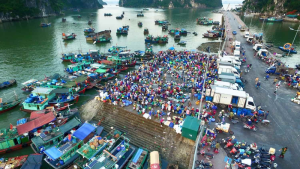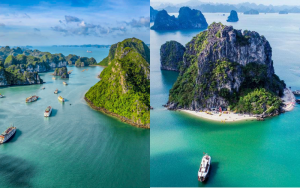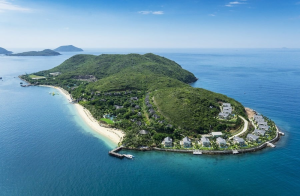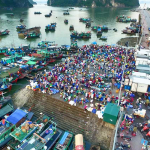Dive deeper into the world of Vung Tau Port, Vietnam’s prominent seaport complex. Explore its components, economic impact, future developments, and gain insights for a well-rounded understanding.
Information About Vung Tau Port
Basic information
Strategic Location: Situated in Bà Rịa-Vũng Tàu province, Vietnam, Vung Tau Port enjoys a prime location bordering the South China Sea. This proximity to major international shipping lanes positions it as a natural gateway for trade, facilitating seamless movement of goods between Vietnam and the global market.
Multifaceted Functionality: Vung Tau Port transcends the role of a mere cargo handling facility. It serves as a cornerstone of Vietnam’s economic prosperity by:
- Facilitating International Trade: The port efficiently handles containerized cargo, expediting import and export activities, thereby fostering economic growth and development through streamlined trade flows.
- Catalyzing Industrial Growth: Vung Tau Port acts as a critical artery for raw materials and finished products, ensuring a steady supply chain that fuels industrial activity and propels Vietnam’s manufacturing sector.
- Generating Employment: From skilled dockworkers to logistics personnel, the port’s operations create a multitude of diverse employment opportunities, contributing significantly to the local economy.
Let’s carefully decode the success of Vung Tau port and anticipate its future!
Delving into the Components of Vung Tau Port
To appreciate Vung Tau Port’s functionality, let’s meet its key players:
- Cai Mep-Thi Vai Port and Sao Mai-Ben Dinh Port: These are the reigning champions of containerized cargo. Cutting-edge infrastructure at these ports allows them to seamlessly handle those giants up to a staggering 50,000 Deadweight Tonnage (DWT), making Vung Tau Port a leader in Vietnam’s booming container trade.
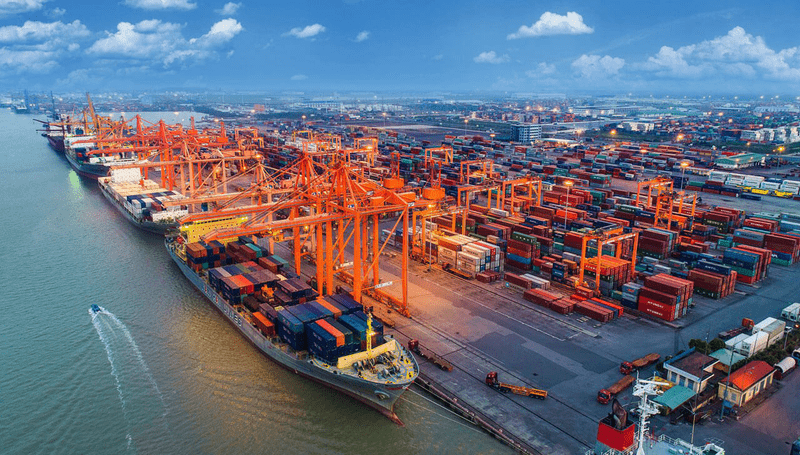
- Phu My Port and My Xuan Port: These versatile ports cater to a broader range of cargo needs. Think general cargo, but with the ability to handle containers as well. Phu My Port, in particular, can welcome vessels up to 30,000 DWT. This adaptability positions Port Vung Tau to accommodate a wider range of cargo types, fostering a dynamic and efficient trade environment.
Strategic Advantages: Why Vung Tau Port Thrives
Location, location, location! Vung Tau Vietnam Port’s success story owes a lot to its strategic position in Southeast Vietnam, bordering the busy South China Sea. Here’s how geography plays a winning hand:
- Proximity to Major Shipping Lanes: Picture this: vessels can conveniently navigate through the South China Sea, connecting Vietnam to global markets with remarkable ease. Vung Tau seaport’s immediate access to major shipping lanes makes it a natural gateway for international trade.
- Seamless Connectivity: Port Vung Tau boasts excellent connections thanks to a well-developed network of roads and inland waterways. Imagine an intricate network efficiently linking the Vung Tau Vietnam port to key economic zones throughout Vietnam. This streamlines the transportation of goods and fosters a vibrant trading environment.
The Economic Powerhouse: Vung Tau Port’s Impact
Vung Tau Port’s influence extends far beyond just cargo handling. It serves as a cornerstone of Vietnam’s economic prosperity, impacting various sectors:
- Trade Facilitation: Ever ordered something online that arrived quickly? Vung Tau Port plays a role in that! The port’s exceptional efficiency in handling containerized cargo expedites import and export activities. This translates to smoother trade flows between Vietnam and its international partners, fostering economic growth and development.
- Industrial Growth Catalyst: Imagine raw materials and finished products seamlessly flowing to and from industrial zones. Port Vung Tau acts as a critical artery for this movement. This ensures a steady supply of essential goods, fueling industrial activity and propelling Vietnam’s manufacturing sector forward.
- Employment Engine: The port’s operations generate a multitude of jobs. From skilled dockworkers meticulously loading and unloading cargo to logistics personnel ensuring everything runs smoothly at Vung Tau Port, it contributes significantly to the local economy by providing diverse employment opportunities.
- Magnet for Foreign Investment: Statistics substantiate Vung Tau’s attractiveness to foreign investors. For instance, Bà Rịa-Vũng Tàu province, where the port is located, ranked first in foreign investment capital in the first four months of 2024, attracting over $1.52 billion in overseas funding, which equates to 16.4% of the total foreign investment in Vietnam. This represents a significant increase compared to the same period in the previous year (Vietnam Investment Review). That’s exactly what makes Vung Tau seaport an irresistible destination for foreign investors. This influx of foreign capital further fuels economic growth, propelling Vietnam’s maritime industry to even greater heights.
A Glimpse into the Future: The Evolution of Vung Tau Port
Vung Tau Port isn’t resting on its laurels. The Vietnamese government, recognizing its immense potential, is actively investing in the port’s expansion and modernization:
- Capacity Expansion: The future promises an increase in Vung Tau Port’s capacity to handle even larger volumes of cargo. Imagine deeper channels allowing for the seamless navigation of even larger vessels, further enhancing the port’s efficiency.
- Infrastructure Upgrade: The focus lies on upgrading existing infrastructure and incorporating cutting-edge technologies. This ensures that Port Vung Tau remains at the forefront of maritime advancements, maintaining its competitive edge in the global trade landscape.
With these ongoing developments, the future of Vung Tau Port appears incredibly promising. As Vietnam’s economy continues its upward trajectory, Vung Tau Seaport is poised to play an even more pivotal role. It will undoubtedly serve as a catalyst for international trade, attract significant foreign investments, and propel Vietnam’s maritime industry towards a bright and prosperous future.
Frequently Asked Questions About Vung Tau Port
Curious to learn more? Here are some answers to commonly asked questions about Vung Tau Port:
-
What types of cargo does Vung Tau Port handle?
Vung Tau Port caters to a diverse range of cargo, ensuring it remains adaptable to the ever-changing demands of international trade. Here’s a breakdown of the main cargo types it handles:
- Containerized Cargo: This is the kingpin at Vung Tau Vietnam Port, especially at Cai Mep-Thi Vai and Sao Mai-Ben Dinh Ports. Imagine these ports buzzing with activity as containerized goods are efficiently managed, playing a vital role in Vietnam’s thriving import and export activities.
- General Cargo: Think of Phu My and My Xuan Ports as the all-rounders within the Vung Tau seaport complex. They excel at handling general cargo, a wider variety of goods that don’t require containers. This includes palletized cargo, bagged goods, steel products, and project cargo like machinery and vehicles.
- Bulk Cargo: While not the primary focus, Port Vung Tau can also handle bulk cargo such as grain, coal, and fertilizer. This versatility ensures the port can cater to the specific needs of various industries.
- Petroleum Products: Vung Tau Port plays a significant role in the Vietnamese oil and gas industry. Imagine dedicated facilities specifically designed for the handling and storage of petroleum products, ensuring the smooth flow of this vital resource within the country.
Readmore: A Tourist’s Guide to Unforgettable Things to Do in Vung Tau
What is The Capacity of Vung Tau Port?
The overall capacity of Vung Tau Port is impressive, but it’s important to consider the individual capacities of each component port:
- Cai Mep-Thi Vai Port and Sao Mai-Ben Dinh Port: These giants boast the capability of accommodating colossal mega-ships exceeding 50,000 DWT. Imagine these ports handling the largest container vessels currently operating, a true testament to their exceptional capacity.
- Phu My Port and My Xuan Port: These ports offer a capacity of up to 30,000 DWT, making them suitable for a wider range of vessel sizes. This flexibility caters to diverse cargo needs and ensures efficient handling of various goods at Port Vung Tau.
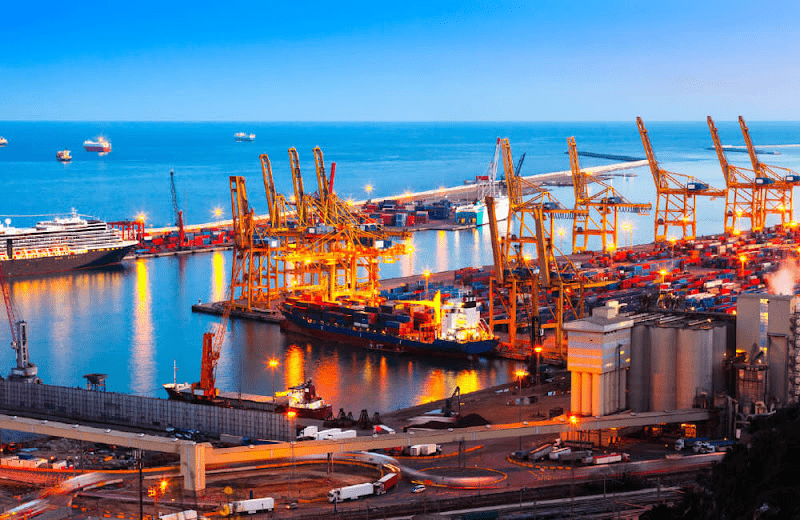
The combined capacity of these ports positions Vung Tau Port as a major player in the global maritime industry, equipped to handle the ever-increasing volumes of cargo traversing international waters.
-
Is Vung Tau Port open to tourists?
While Vung Tau seaport itself is primarily an industrial zone with restricted public access, tourists can still experience the vibrancy of Vung Tau City, conveniently located nearby. Imagine relaxing on stunning beaches like Front Beach and Back Beach, or immersing yourself in Vietnam’s rich heritage by visiting historical landmarks like the Niet Thu Cau (White Palace) and the Linh Son Co Tu (The Lady Hermit Pagoda).
Tourists can even embark on boat tours or cruises departing from Vung Tau, offering a unique perspective of the bustling port activities at Vung Tau Port from the open water.
-
How can I learn more about Vung Tau Port?
For the latest information and updates on Vung Tau Port, you can explore the following resources:
- Vietnam Seaports Association Website: This official website provides valuable insights into the Vietnamese port landscape, including Port Vung Tau. Imagine yourself browsing this website to learn more about the port’s operations and its significance within Vietnam’s maritime industry.
- News Articles: Stay up-to-date by searching online using keywords like “Vung Tau Port expansion” or “Vung Tau Port investment”. Imagine reputable news sources offering informative articles and reports on developments related to Vung Tau Port.
- Port Operator Websites: Individual port operators within the Vung Tau Vietnam port complex might also have websites with specific details about their facilities and services. Imagine finding dedicated websites for each port, offering a deeper dive into their offerings and their role within the larger Vung Tau Port complex.
By delving into these resources, you can gain a deeper understanding of Vung Tau Port’s intricate operations, its significance within the Vietnamese economy, and its projected future trajectory.
This comprehensive overview aims to shed light on Vung Tau seaport, a crucial maritime hub propelling Vietnam’s economic growth. With its strategic location, exceptional capacity, and ongoing developments, Vung Tau Port is poised to remain a dominant force in the global maritime landscape for years to come.
Readmore: Vung Tau where to stay?: Top best hotels in Vung Tau



